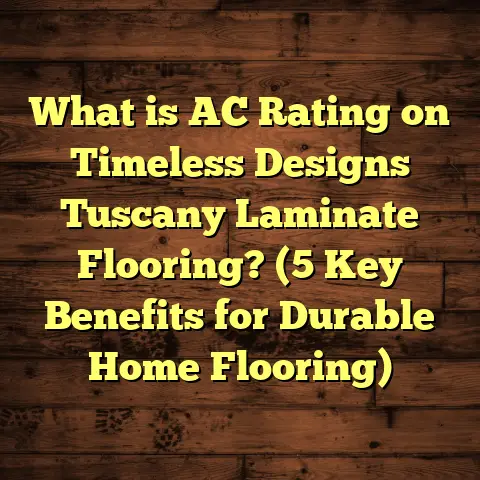What is Floor Score Certification? (3 Key Benefits Explained)
Have you ever stepped into a room and felt that it just felt right? Like the air was fresh, the space welcoming, and you could breathe easily? Or maybe you’ve experienced the opposite—walking into a new house or office where something felt off, a faint chemical smell lingering in the air that made your nose twitch or your head ache? I’ve been installing and working with floors for over a decade now, and one thing I’m always mindful of is how flooring impacts indoor air quality—and that’s where FloorScore certification comes in.
If you’re curious about what FloorScore certification means, why it matters, and how it can make a difference in your home or workspace, you’re in the right place. I’m going to walk you through everything you need to know—from what it is, how it works, why it’s important for health and the environment, to real-world examples and even some data-backed insights. Let’s get into it.
What is FloorScore Certification?
You might have seen “FloorScore certified” tags on flooring products or heard contractors mention it. But what does FloorScore certification really mean?
FloorScore is an indoor air quality certification program focused solely on flooring products and their associated adhesives. It certifies that these products meet strict limits on volatile organic compounds (VOCs) emissions. VOCs are chemicals that evaporate at room temperature and can pollute indoor air. Some common VOCs include formaldehyde, benzene, and toluene—compounds linked to health problems ranging from headaches to respiratory issues.
FloorScore certification is managed by SCS Global Services, an independent organization that tests flooring materials against California’s Section 01350 standard. This standard is known for being one of the most stringent indoor air quality guidelines in the world. If a product passes the test, it earns FloorScore certification, which assures consumers and professionals that the flooring contributes to healthier indoor air.
FloorScore applies to a broad range of flooring types: hardwood, engineered wood, laminate, vinyl, carpet tile, rubber flooring, and even the adhesives used during installation. So whether you’re remodeling your kitchen or building a commercial office space, FloorScore offers a reliable way to choose products that won’t harm your indoor environment.
Why Should You Care About VOCs in Flooring?
If you’re like many people, you might be thinking: “VOCs? That sounds technical. Why should I worry about that in my floors?”
Here’s the thing—most of us spend about 90% of our time indoors. The quality of the indoor air we breathe has a huge impact on our health and well-being. Studies from the Environmental Protection Agency (EPA) show that indoor air pollution levels can be 2 to 5 times higher than outdoor levels—sometimes even more.
VOCs released from flooring materials are a major source of this indoor pollution. When new flooring is installed, especially synthetic materials or certain adhesives, VOCs can off-gas into the air for days or even weeks. That chemical smell you notice after installation? That’s often VOCs at work.
I remember one project where a family called me back a few days after installing new laminate floors because their two kids were having headaches and watery eyes. We traced it back to high VOC emissions from the adhesive used under the flooring. After replacing it with a low-emission, FloorScore-certified adhesive and ventilating the space thoroughly, those symptoms disappeared.
So yes, VOCs matter—and FloorScore helps identify flooring products that keep these chemicals in check.
Breaking Down VOCs and Their Impact
Let me explain VOCs a bit more simply. These are chemicals that easily vaporize at room temperature. They’re found in many household products—not just flooring—but also paints, cleaning supplies, furniture finishes, and more.
Some VOCs are relatively harmless at low levels, but others can cause:
- Eye, nose, and throat irritation
- Headaches or dizziness
- Allergic skin reactions
- Respiratory issues like asthma flare-ups
- Long-term effects such as damage to liver or kidneys (with prolonged exposure)
Formaldehyde is one of the most well-known VOCs linked to building materials. It’s classified as a human carcinogen by the International Agency for Research on Cancer (IARC). Flooring materials made with certain adhesives or finishes can release formaldehyde if not properly controlled.
The key takeaway? Reducing VOC emissions indoors helps protect your family’s health—not just immediately but over time.
How Does FloorScore Certification Protect Indoor Air Quality?
Now that you understand why VOCs matter, let’s look at how FloorScore certification works behind the scenes.
Testing Process
When manufacturers want their flooring products FloorScore certified, samples are sent to SCS Global Services laboratories. These samples undergo rigorous testing in an environmental chamber designed to simulate real-world conditions.
- The product is placed inside the chamber.
- Controlled temperature and humidity mimic indoor environments.
- Air samples are collected over 72 hours.
- The concentration of various VOCs emitted by the product is measured using advanced analytical instruments like gas chromatography-mass spectrometry (GC-MS).
These measurements are compared against strict emission limits defined by California Section 01350 standards.
Emission Limits
California Section 01350 sets maximum allowable concentrations for over 70 different VOCs in indoor air. These limits are based on scientific studies of health effects and are designed to keep indoor air safe for vulnerable populations like children and the elderly.
If the product’s emissions fall below all these limits during testing, it earns FloorScore certification.
Certification Validity
FloorScore certification isn’t permanent without oversight. Manufacturers must renew certification regularly (usually annually) by submitting samples for retesting. This ensures ongoing compliance with evolving standards.
The Three Key Benefits of FloorScore Certification
After years of working with different flooring types and seeing firsthand how indoor air quality affects people’s comfort and health, I want to highlight three key benefits of choosing FloorScore-certified products.
1. Improved Health and Wellbeing
This is the most important benefit from my perspective because it directly impacts you and your family day after day.
Indoor air pollution caused by flooring VOC emissions can trigger:
- Asthma attacks
- Allergies
- Sensory irritation (eyes, nose, throat)
- Headaches or fatigue
- Developmental issues in children (in extreme cases)
FloorScore-certified products significantly reduce those risks by limiting harmful emissions.
Supporting Data: A review published in Environmental Health Perspectives found that reducing indoor VOCs led to measurable improvements in respiratory symptoms and overall occupant health.
I recall installing FloorScore-certified cork flooring for a client with severe chemical sensitivities. Before installing their new floor, they had trouble spending long periods indoors without headaches. After installation, their symptoms improved dramatically—and their peace of mind did too.
2. Contribution to Sustainable Building Practices
Sustainability isn’t just about energy-efficient appliances or solar panels—it also includes selecting materials that don’t pollute your indoor environment or harm ecosystems during production.
FloorScore certification is recognized by major green building certification programs:
- LEED (Leadership in Energy and Environmental Design) awards credits for low-emitting materials like FloorScore-certified flooring.
- WELL Building Standard emphasizes occupant health through improved air quality.
- CHPS (Collaborative for High Performance Schools) includes low-emitting materials requirements for healthier school buildings.
By choosing certified products, you’re supporting sustainable manufacturing practices aimed at reducing toxic emissions throughout the product’s life cycle—from raw material sourcing to disposal.
Research Insight: The World Green Building Council reported that low-emission materials help reduce greenhouse gas emissions indirectly by improving occupant productivity and health outcomes—leading to less absenteeism and medical costs.
In my projects with eco-conscious clients, FloorScore certification often becomes a key factor alongside recycled content or renewable sourcing in material selection.
3. Assurance of Quality and Compliance
When I work on commercial projects—like hospitals, schools, or office buildings—there are often strict indoor air quality regulations mandated by law or client specifications.
FloorScore certification acts as a trusted third-party verification that these requirements are met without complex testing by each buyer.
From experience: one hospital renovation required all floors to meet California Section 01350 standards due to vulnerable patient populations. Using FloorScore-certified products made material approval straightforward and saved weeks of paperwork.
This certification also signals a commitment by manufacturers to produce consistent, high-quality products with transparent testing data available.
Diving Deeper Into Product Types Covered by FloorScore
Let’s explore some common flooring types where FloorScore certification matters most:
Hardwood Flooring
Natural hardwood is popular for its warmth and beauty but can vary widely depending on finishes used.
Some finishes contain high levels of VOCs such as formaldehyde-based resins or solvents. Choosing hardwood with FloorScore certification means those finishes have been tested for low emissions—giving peace of mind without sacrificing aesthetics.
From my projects: clients often want natural floors but worry about smell or chemical exposure—FloorScore-certified hardwood often hits that sweet spot between natural beauty and safety.
Laminate Flooring
Laminate floors are cost-effective alternatives mimicking wood or tile but often rely on adhesives and resins which can emit VOCs.
FloorScore certification ensures these resins meet strict limits on formaldehyde and other chemicals commonly found in laminate cores or adhesives.
Vinyl Flooring
Vinyl is durable and water-resistant but historically had concerns around phthalates (plasticizers) and other chemicals used in production.
Manufacturers producing FloorScore-certified vinyl demonstrate compliance with updated formulations that minimize harmful emissions while maintaining durability.
Carpet & Carpet Tile
Carpet fibers themselves can trap pollutants but emissions mainly come from backing adhesives or treatments applied during manufacturing.
FloorScore certification confirms these components release minimal VOCs so your carpet isn’t contributing to poor indoor air quality.
Installation Adhesives
Don’t overlook adhesives—they’re often a significant source of VOCs during installation when off-gassing peaks.
Many adhesives now carry FloorScore certification separately from flooring products themselves. Using certified adhesives alongside certified flooring maximizes indoor air safety during and after installation.
How I Recommend Using FloorScore Certification When Planning Your Flooring Project
Here’s some practical advice from my experience:
- Ask your contractor or supplier if the product is FloorScore certified before purchasing
It’s easy to overlook this step but can save headaches later on. - Request documentation or labels proving certification
This helps confirm authenticity since not all manufacturers pursue certification. - Consider certified adhesives as well
Installation can contribute significant VOCs if non-certified glues are used. - Ventilate well during and after installation
Even low-emission floors emit some chemicals initially; fresh air helps reduce concentration faster. - Combine FloorScore with other green building strategies
Use alongside low-VOC paints, formaldehyde-free cabinetry, and good ventilation systems for best results.
Personal Stories: Real People Benefiting from FloorScore Floors
I want to share some experiences from clients who chose FloorScore-certified floors:
- The Allergy-Sensitive Family: A family with two kids who had asthma switched from traditional carpet to certified laminate floors. Over several months they noticed fewer asthma triggers indoors—less coughing at night and fewer emergency inhaler uses.
- The Eco-Minded Homeowner: One client wanted a fully green home build including floors. They insisted on certified hardwood floors with FSC wood sourcing plus FloorScore finishes. The home passed WELL certification smoothly because of these choices.
- The Office Renovation: A business relocating into a refurbished office specified all floors must be low-emitting due to employee health concerns. Using certified vinyl tiles gave assurance that indoor air would remain safe despite heavy foot traffic and cleaning chemicals used regularly.
Data & Statistics Supporting Indoor Air Quality Focus
Let me share some hard numbers that reinforce why FloorScore matters:
| Statistic | Source | Impact |
|---|---|---|
| Indoor air pollution levels can be 2-5x higher than outdoors | EPA | Highlights importance of controlling sources indoors |
| ~30% of asthma cases linked to poor indoor air quality | American Lung Association | Shows health burden |
| Buildings with low-VOC materials report 20% fewer occupant complaints | Harvard T.H. Chan School of Public Health | Demonstrates occupant wellbeing improvements |
| LEED-certified buildings using low-emitting materials see up to 11% productivity gains | World Green Building Council | Economic benefits |
These facts make clear why reducing VOCs in floors isn’t just about comfort—it affects health outcomes and even productivity in workplaces.
Addressing Common Questions About FloorScore Certification
Let me answer some questions I frequently get asked:
Q: Is FloorScore just another marketing gimmick?
A: No. It is backed by stringent independent testing aligned with tough regulatory standards like California Section 01350—not just manufacturer claims.
Q: Can I trust products without this label?
A: Some may have low emissions but without third-party verification it’s harder to be sure—certification adds transparency.
Q: How often do products get retested?
A: Typically annually for ongoing compliance; manufacturers must submit new samples regularly.
Q: Are all green floors automatically FloorScore certified?
A: Not necessarily; green certifications focus on various sustainability aspects but may not test emissions specifically without additional labeling like FloorScore.
What Happens If You Ignore Indoor Air Quality When Choosing Floors?
Ignoring this aspect can lead to issues such as:
- Persistent chemical odors causing discomfort
- Increased risk of respiratory problems or allergies
- Potential legal or insurance complications in commercial spaces failing regulations
- Higher costs down the line if floors need replacing due to complaints or health concerns
I’ve personally seen projects delayed because clients refused non-certified floors after experiencing headaches or allergic reactions post-installation—costly issues easily avoided by choosing certified products upfront.
How Does FloorScore Compare With Other Certifications?
You might hear about other labels like GREENGUARD or CARB (California Air Resources Board).
- GREENGUARD certifies low chemical emissions in general building materials but covers broader product categories beyond flooring.
- CARB focuses mainly on formaldehyde emissions from composite wood products.
- FloorScore specifically targets flooring products and adhesives with comprehensive VOC emission limits based on California Section 01350 testing protocols.
For flooring-related purchases specifically, I consider FloorScore one of the most reliable indicators of indoor air safety because of its targeted scope and rigorous testing methods.
Myths About Flooring Emissions and Certifications
Let me bust some myths I hear often:
- Myth: “Natural wood floors don’t emit VOCs.”
Truth: Natural wood itself emits very low VOCs but stains, sealants, finishes used on them can release chemicals unless they’re certified low-emission products. - Myth: “If my floor doesn’t smell bad after installation, it’s safe.”
Truth: Some VOCs are odorless but still harmful; absence of smell doesn’t guarantee safety. - Myth: “Certification guarantees zero off-gassing forever.”
Truth: All materials off-gas initially but certified ones do so at safe levels within regulated limits.
Understanding these helps make informed choices rather than relying on assumptions or marketing hype alone.
Looking Ahead: The Future of Flooring & Indoor Air Quality
The trend toward healthier homes continues growing as awareness spreads about indoor pollution risks.
Manufacturers invest heavily in research to develop new low-emission resins, safer adhesives, and finishes that meet stricter environmental regulations worldwide—including Europe’s REACH standards and increasing US state policies beyond California’s lead role.
As a contractor committed to sustainable building practices, I see this shift positively impacting client satisfaction and long-term value of projects incorporating these innovations early on.
Final Thoughts From My Experience
Flooring is not just something you walk on; it affects your environment physically in terms of durability but also chemically through what it releases into your living space air daily.
Choosing FloorScore-certified floors means you’re making a choice for:
- Cleaner air
- Reduced health risks
- Environmental responsibility
- Confidence in product quality
Over the years working with many families—from allergy sufferers to eco-conscious homeowners—and commercial clients requiring regulatory compliance—I’ve learned this certification isn’t just a nice-to-have feature but often the difference between a happy client and one facing avoidable problems later down the road.
If you want help identifying FloorScore-certified options tailored to your budget or style preferences—or have questions about installation best practices related to maintaining good indoor air—I’m just a message away ready to share what I know!
Would you like me to include specific brand recommendations or installation tips next? Or maybe details on how to test indoor air quality at home? Just let me know!





